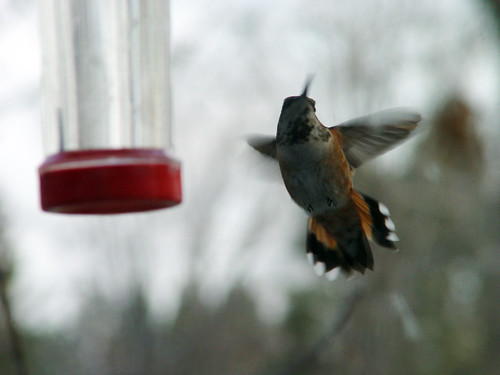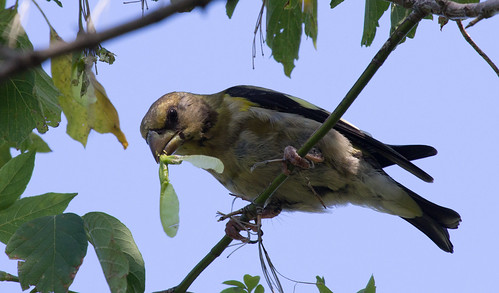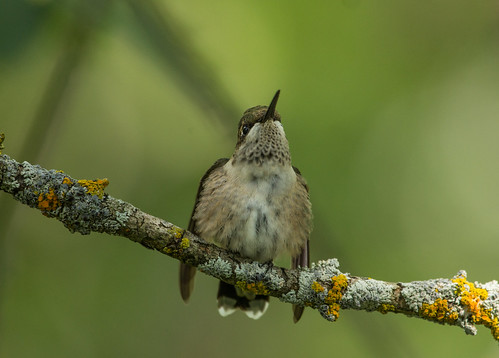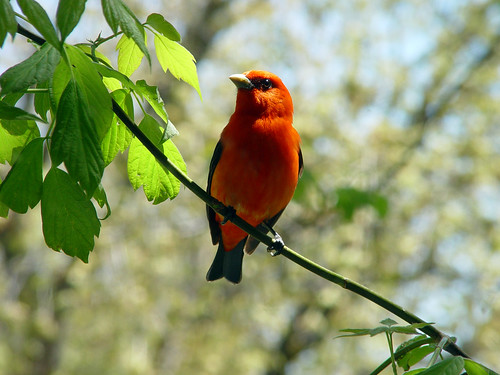The autumn of 2014 has been characterized by one of the best migrations in years, as far as the number of birds showing up in my backyard, especially warblers and sparrows. The warblers never once appeared at my feeders, at least not while I was looking, but I saw quite a few, especially in August and the first half of September, out my upstairs home office windows—some even gave me wonderful photo ops. As of September 30, there were still plenty of Palm and Yellow-rumped Warblers hanging out, and that week, I was still getting some nice photos of Blackpoll Warblers and American Redstarts, even as I was mostly aiming my camera at the hundreds of sparrows crowding into my lawn where I scatter seed by my back spruce trees and raspberry bushes.
 |
|
I’m on a corner lot, but the road along the side was never finished. My house, which started out as a tiny bungalow in the early 1900s, was the first one built on this stretch of Peabody Street, when the road was just a horse path. As the neighborhood grew and the road widened, other houses were set further back. That gives us a tinier front lawn and a bigger backyard than anyone else on the block. A boy born sometime before 1916 planted a small stand of spruce trees in the back of the yard. Those trees and the other grand old trees in the yard were what caught my eye when I walked by in early 1981, looking for an affordable house for sale, and over the years, those trees have anchored my heart here as deeply as the house itself. We started out with raspberries along our side fence. Those suddenly died out, but the very next year, a whole new patch sprouted up in back, planted by birds. So we never feel too upset when they eat raspberries—sharing our territory is part of what nature is all about.
 |
| I took this photo in Two Harbors--it's the only one on this blog post that wasn't taken right in my yard. I don't have any decent photos of owls from here, but I've seen Eastern Screech-Owl (the rarest one for here, seen and heard in a fall when Frank Nicoletti banded two in Duluth), Great Horned, Barred, Great Gray, Long-eared, Boreal, and Northern Saw-whet Owls. Not a bad list for a regular old neighborhood! |
The trees and other plants in my yard are the feature that draws so many cool birds here. Peabody Street runs along the prime migration path through Duluth between Hawk Ridge and Lake Superior. Although this is just a regular, settled, working class neighborhood, over the years I’ve seen an astonishing 7 species of owls for my yard list, along with a couple of Townsend’s Solitaires, one Varied Thrush, and a Rufous Hummingbird that stuck around for 2 ½ weeks late in November 2004.
A blizzard while the hummer was still visiting made me so worried that I left my window wide open so she could come in and warm up a bit. Thanks to the already-opened window, when a Pileated Woodpecker suddenly flew into the box elder right next there, I had perfect photo ops. This was before I was using a good camera, but the bird was so close that it didn’t matter.
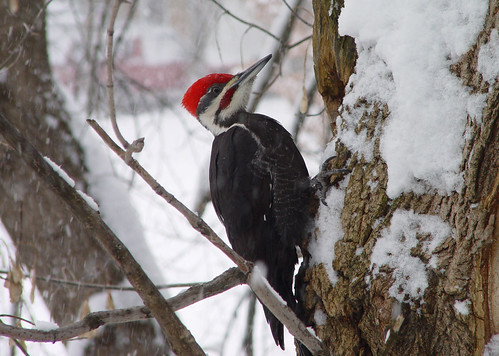 |
|
Great as my yard is, I've never had a lifer here. The closest three times I came were in our first year here. I followed Kim Eckert's directions to find my lifer Boreal Chickadee a bit north of Two Harbors in the summer, when if I'd been patient, I'd have seen the lifer in my own yard that winter. In early winter, Kim called to tell me about Bohemian Waxwings a few blocks away in my neighborhood, which I instantly charged out to see. A few days later, they were in my own mountain ash trees. But the worst case was when Kim called to tell me about some Harris's Sparrows out on Park Point my first October here. I drove out and easily found them, and drove home to find one right under my own bird feeder.
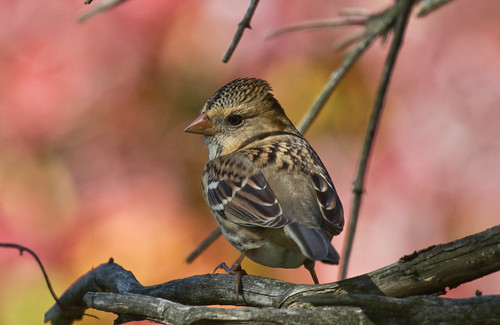 |
|
Even though they weren't lifers here, I've treasured seeing all three of those species in my yard over the years. Bohemian Waxwings used to be here every winter—they're not so reliable anymore. But every spring and fall at least a few Harris's Sparrows show up. And three or four times since 1981, one or more Boreal Chickadees have spent much of the winter visiting my peanut butter feeders.
One of my favorite yard birds of all has been the Evening Grosbeak. Throughout the 80s and into the 90s, when they were still abundant, I always seemed to have more than most people in town, thanks to my box elders. I'd gone over a decade without seeing more than an occasional single straggler when Russ had surgery in 2011. Our first morning after he came home, out of the clear blue sky, a flock of 16 showed up and remained in our yard for weeks. I haven't seen one here since, but those birds were an astonishingly welcome gift at such a bleak time.
My box elder has given me wonderful photo ops for other kinds of birds, too. Many of the hummingbirds that dine at my window feeder then head straight to the tiny twigs right near the window, allowing me to watch them preen, stretch, and rest. The various fungi and lichens on the branches add color and texture to my photos even as they signal a warning that the tree isn’t going to last forever.
But I try not to fret about it—when we moved here, my mother-in-law cautioned us that we should cut down that very tree immediately because it looked so old and precarious. That was 33 years ago. Now the tree and I are both a bit past our prime. I’ve lost 2 of the spruce trees in back, our birch tree is losing ground, and the elm tree that sprouted in 1983 and got big had to be cut down a few years ago because of Dutch elm disease. Several of the branches on the cherry trees Russ planted are dead now, too.
We’re developing plans to plant more trees next year, but little by little the yard is changing. My goal, as always, is to adapt to those changes while keeping the yard a safe haven for the flood of birds passing through. I try to be generous spirited, but really, everything I do to help those birds directly improves my quality of life, too. Home is where the heart is, but in my case, that’s in large part because home is where my birds are.


